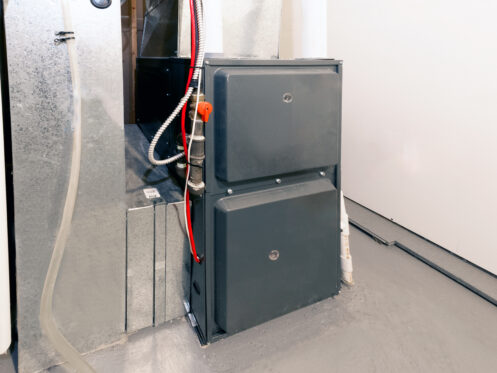Most households have residents with vastly different temperature preferences. Some love their living spaces toasty and warm, and others like the feel of crisp, cool air. Standard central heating systems aren’t flexible enough to meet each of these needs at once. These systems heat and cool homes uniformly. Zoning eliminates this limitation by dividing building interiors into separate service areas or zones. If you’re curious about zoning the heating system in your Oklahoma City, OK home, the following are five impressive benefits that zoning provides.
1. Prevent Vent Closures and All of the Problems They Cause
Both adjustable and accessible, HVAC air vents appear to offer a way to customize indoor temperature control. By simply sealing vents shut, residents can redirect air away from their immediate vicinity. However, this isn’t really what HVAC air vents are for. Moreover, sealing them shut and keeping them that way can cause air conditioners, heat pumps, and furnaces to short cycle, overheat, ice over, or experience other problems.
Why Vent Closures Are Problematic
If you compare the air vents throughout your home, you might notice that each is in a slightly different position. When performing air balancing services to ensure even air delivery, HVAC technicians strategically adjust these features. Closing vents completely undoes this work and makes it difficult to achieve consistent air delivery without scheduling air balancing services again.
Vent closures also place a considerable amount of stress on HVAC equipment. When residents close their HVAC air vents, unwanted air has nowhere to go. This creates rapid and dramatic increases in in-duct air pressure that could ultimately lead to the temporary shutdown or premature failure of heating equipment. This is especially true when numerous vents throughout the home are closed at once and left that way indefinitely.
HVAC zoning offers the customization that vent closures provide, but without causing undue stress or HVAC equipment damage. In zoned HVAC systems, each zone has its own thermostat, and each thermostat is independently controlled by building residents. When people no longer want heating in their zones, their thermostats will send signals that trigger the closure of duct dampers. When duct dampers are sealed shut, conditioned air is routed into bypass ducting to moderate air pressure and keep the entire HVAC system running smoothly.
Everyone Can Enjoy Their Preferred Climate
If you have your HVAC system zoned, you’ll never have to worry about residents closing their air vents again. People who tend to feel stuffy and congested when the heater is running can turn their thermostats down and enjoy cooler air in their preferred spaces.
2. Stop Paying to Heat Unoccupied Rooms or Spaces
Zoned HVAC systems can have between two and four zones. In larger homes with two or more stories, people often have separate zones and thermostats on each floor. If everyone in your home retires at night to upstairs bedrooms, it makes no sense to heat downstairs areas. With a zone on each floor, you can keep your sleeping spaces cozy without having to heat your living room, den, home office, or kitchen.
Zoning also works well in homes with residents who are frequently absent. For instance, you might have someone in your household who’s gone for days or weeks for work or school. With zoning, you won’t have to heat their room while they’re away, and you can still enjoy the temperature you want in other areas.
3. Discover the Enhanced Functionality of Smart Thermostats
Thermostats act as the brains of HVAC systems. Given their complex designs, functions, and driving technologies, zoned HVAC systems require smart thermostats. If you haven’t made the upgrade to smart thermostats yet, you’ll love their greatly enhanced capabilities and features.
Like programmable thermostats, smart thermostats can hold multiple pre-scheduled temperature changes. However, these devices are also both learning and Wi-Fi-enabled. Over time, they become increasingly adept at adjusting their own settings according to the comings and goings of building residents. With branded smart thermostat apps, consumers can monitor and adjust these devices from any location using their mobile phones, laptops, or tablets.
Smart thermostats additionally collect data on HVAC system use, energy use, indoor air quality, and more. They can compile this data into basic reports that consumers can use to make informed decisions. Many smart thermostats also send out regular reminders for HVAC air filter changes and annual tune-up services. According to ENERGY STAR, smart thermostats could help homeowners reduce their heating and cooling costs by up to 8% each year.
4. Modernize Your Home With HVAC Zoning
Smart thermostats and zoned heating systems are the wave of the future. They allow for greater precision in indoor climate control. This precision minimizes energy waste and optimizes the efficiency of HVAC systems. It also makes it easier for homeowners to identify problems early on and dress them before they have an impact on their energy bills or the health and lifespan of their HVAC equipment.
These are all attributes that appeal to savvy, modern buyers. Although many investors appreciate the classic or rustic charm of older homes, they still want the savings, convenience, and smaller carbon footprints that come with HVAC system upgrades. After all, according to the U.S. Department of Energy (DOE), throughout certain points of the year, HVAC system use accounts for nearly half of the average home energy bill.
If you’re looking for a way to modernize your home, zoning is an excellent choice. Zoning will set your property apart from comparable houses in your area that have yet to make this upgrade. It will also add value to your investment and make it easier to sell at a desirable price point.
5. Integrate Your HVAC System With Other Smart Home Features
Zoned heating systems can be seamlessly integrated with other smart home features. For instance, if you have smart home blinds, your home’s control system can open your window treatments in the afternoon to limit demand on your heater. Capitalizing on solar heat gains is an effective way to save cash. With an intelligent, zoned HVAC system, all of your smart home features will work seamlessly together to save you money and create the indoor conditions you want. Many smart thermostats and other smart home features with geo-fencing capabilities can additionally attune their functions to the movements and whereabouts of building residents.
Is Zoning Right for You?
Zoning is an excellent choice for any large household with diverse home comfort needs. If there are frequent arguments in your home over the thermostat setting or if you’ve noticed multiple HVAC air vent closures in the past, zoning your HVAC system could solve these problems. HVAC zoning also works well in multi-level properties in which uniform, whole-house heating wastes considerable amounts of energy. With thermostats on each floor or a living space that’s divided into as many as four service areas, you can easily limit your HVAC system use to occupied spaces only.
We’ve been proudly serving Oklahoma City, OK since 2005. You can count on us for superior heating, cooling, plumbing, and air quality services. To find out about our savings membership, ask questions about HVAC zoning, or schedule an appointment, contact True Climate Heat + Air now.


